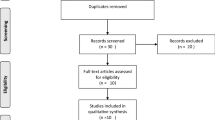Abstract
Background
Oral submucous fibrosis (OSMF) is a chronic disease of the oral cavity which presents clinically with burning sensation, leathery consistency of oral mucosa with palpable fibrous bands leading to reduced mouth opening. Though the evaluation of quality of life (QOL) in health care is gaining importance, researches regarding the evaluation of QOL in OSMF individuals are very sparse.
Aim
The aim of the present study is to evaluate the QOL assessment in OSMF patients through WHOQOL-BREF questionnaire.
Methodology
The study includes a total of 300 participants recruited from the outpatient department. The quality of life was assessed using the WHOQOL-BREF questionnaire. The raw scores for the physical health, psychological health, social relationships and environmental health domains were done on 4–20 scale suggested by the WHOQOL procedural manual. The analysis of variance (ANOVA) was used for the simultaneous comparison of mean scores for the four domains, and independent t test was used for the comparison of two means of domain scores.
Results
The participants with OSMF have a significant negative impact on the quality of life when compared with the participants without OSMF (P = 0.002). The environmental factors in the WHOQOL-BREF have shown a significant difference in the QOL of participants with OSMF than without OSMF (P = 0.001).
Conclusion
The oral submucous fibrosis has a negative impact on the quality of life in participants with OSMF specifically in social and environmental domains of the WHOQOL-BREF questionnaire.
Similar content being viewed by others
References
Ranganathan K, Devi MU, Joshua E et al (2004) Oral submucous fibrosis: a case control study in Chennai, South India. J Oral Pathol Med 33:274–277. https://doi.org/10.1111/j.0904-2512.2004.00116.x
Caniff JP, Harvey W (1981) The etiology of oral submucous fibrosis: the stimulation of collagen synthesis by extracts of areca nut. Int J Oral Surg 10:163–167
Gupta PC, Sinor PN, Bhonsle RB et al (1998) Oral submucous fibrosis in India: A new epidemic? Natl Med J India 11:113–116
Shah N, Sharma PP (1998) Role of chewing and smoking habits in the etiology of oral submucous fibrosis (OSMF): a case control study. J Oral Pathol Med 27:475–479
Shahid RA (2010) Coming to America: betel nut and oral submucous fibrosis. JADA 141:423–428
Rajendran R (1994) Oral submucous fibrosis: etiology, pathogenesis and future research. WHO Bull OMS 72:986–996
Gupta SC, Singh M, Khanna S et al (2004) Oralsubmucous fibrosis with its possible effect on Eustachiantube functions: a tympanometric study. Indian J Otolaryngol Head Neck Surg 56:183–185. https://doi.org/10.1007/BF02974346
Pindborg JJ, Mehta FS, Gupta PC et al (1968) Prevalence of oral submucous fibrosis among 50,915 Indian villagers. Br J Cancer 22:646–654
Olweny CL (1992) Quality of life in developing countries. J Palliat Care 8:25–30
Szabo S (1996) The world health organisation quality of life (WHOQOL) assessment instrument. In: Spilker B (ed) Quality of life and pharmaeconomics in clinical trials, 2nd edn. Lippincott-Raven Publishers, Philadelphia
Gill TM, Feinstein AR (1994) A critical appraisal of the quality of quality-of-life measurements. JAMA 272:619–626
Nigam NK, Aravinda K, Dhillon M et al (2014) Prevalence of oral submucous fibrosis among habitual gutkha and areca nut chewers in Moradabad district. J Oral Biol Craniofac Res 4:8–13. https://doi.org/10.1016/j.jobcr.2013.10.005
Heutte N, Plisson L, Lange M et al (2014) Quality of life tools in head and neck oncology. Eur Ann Otorhinolaryngol Head Neck Dis 131:33–47
Riordain RN, McCreary C (2011) Validity and reliability of a newly developed quality of life questionnaire for patients with chronic oral mucosal diseases. J Oral Pathol Med 40(8):604–609. https://doi.org/10.1111/j.1600-0714.2011.01021.x
Striner DL, Norman GR (2008) Health measurement scales: a practical guide to their development and use, 4th edn. Oxford University Press Inc, New York
Ritva K, Pekka R, Harri S (2000) Agreement between a generic and disease-specific quality-of-life instrument: the 15D and the SGRQ in asth-matic patients. Qual Life Res 9(9):997–1003. https://doi.org/10.1023/A:1016698818258
Lopez JP, Camacho AF, Lucero BM (2009) Measuring the impact of chronic oral mucosal disease on quality of life. Eur J Dermatol 19(6):603–606. https://doi.org/10.1684/ejd.2009.0762
Suliman NM, Johannessen AC, Ali RW et al (2012) Influence of oral mucosal lesions and oral symptoms on oral health related quality of life in dermatological patients: a cross sectional study in Sudan. BMC Oral Health 8:12–19. https://doi.org/10.1186/1472-6831-12-19
Villanueva-Vilchis MD, Lopez-Rios P, Garcia IM et al (2016) Impact of oral mucosa lesions on the quality of life related to oral health. An etiopathogenic study. Med Oral Patol Oral Cir Bucal 21(2):e178–e184
Tadakamadla J, Kumar S, Lalloo R et al (2017) Qualitative analysis of the impact of oral potentially malignant disorders on daily life activities. PLoS ONE 12(4):e0175531. https://doi.org/10.1371/journal.pone.0175531
Tabolli S, Bergamo F, Alessandroni L et al (2009) Quality of life and psychological problems of patients with oral mucosal disease in dermatological practice. Dermatology 218:314–320. https://doi.org/10.1159/000196973
Lopez-Jornet P, Camacho-Alonso F, Lucero Berdugo M (2009) Measuring the impact of oral mucosa disease on quality of life. Eur J Dermatol 19(6):603–606. https://doi.org/10.1684/ejd.2009.0762
Chu NS (2001) Effects of betel chewing on the central and autonomic nervous systems. J Biomed Sci 8:229–236. https://doi.org/10.1159/000054038
Gupta PC, Warnakulasuriya S (2002) Global epidemiology of areca nut usage. Addict Biol 7:77–83. https://doi.org/10.1080/13556210020091437
Kandelman D, Petersen PE, Ueda H (2008) Oral health, general health, and quality of life in older people. Spec Care Dentist 28(6):224–236. https://doi.org/10.1111/j.1754-4505.2008.00045.x
Author information
Authors and Affiliations
Corresponding author
Rights and permissions
About this article
Cite this article
Chaudhry, K., Bali, R., Patnana, A.K. et al. Impact of Oral Submucous Fibrosis on Quality of Life: A Cross-Sectional Study. J. Maxillofac. Oral Surg. 18, 260–265 (2019). https://doi.org/10.1007/s12663-018-1114-3
Received:
Accepted:
Published:
Issue Date:
DOI: https://doi.org/10.1007/s12663-018-1114-3



